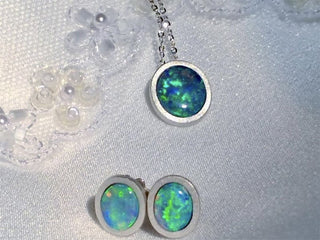Opal - Etymology : from the Latin opalus - opal which in turn derives from the Sanskrit upala - precious stone.

Opal is a precious stone with varying colors and transparency, as is its chemical composition, which cannot be defined with a precise formula, as the mineral's water content varies depending on the location and depth of the deposit. Opal is a colloidal substance composed of hydrated amorphous silica containing traces of calcium, magnesium, aluminum, iron, and uranium.

Crystallization: Usually absent - amorphous colloidal substance.
Chemical composition: hydrated silica anhydride (SiO² + H²O) (in quantities varying from 3 to 20%). Opal is formed by the slow geological deposition of a colloidal silica gel at low temperatures.
Hardness: 5.5 - 6.5
Density: 1.9 - 2.3
Refraction: simple (monorefractive)
Refractive index: n = 1.23 - 1.46
The electron microscope shows the disordered hydrated silica spherules, which result in a colorless or slightly colored common opal (potch) (left photo). The ordered opal spherules (right photo) are the basis of colored precious opal.

Mining: The homeland of opal is Australia, where the largest mining sites are located, such as Coober Pedy, Lightning Ridge, Mintabie, Quilpie, Andamooka, etc. Ethiopia, Brazil, Mexico, Honduras, Peru, and Arizona (USA) are also important opal mining locations, each with a very diverse play of color. Opal is also found in Italy, especially in the Baldissero (Turin) area of Piedmont, but being white and colorless, it has no commercial value.

Varieties: In nature, opal takes on a wide variety of shapes, colors, and characteristics. The following types of opal are commonly used in jewelry: black (by far the most valuable), white, gray, crystal, boulder, matrix, and fire opal.





